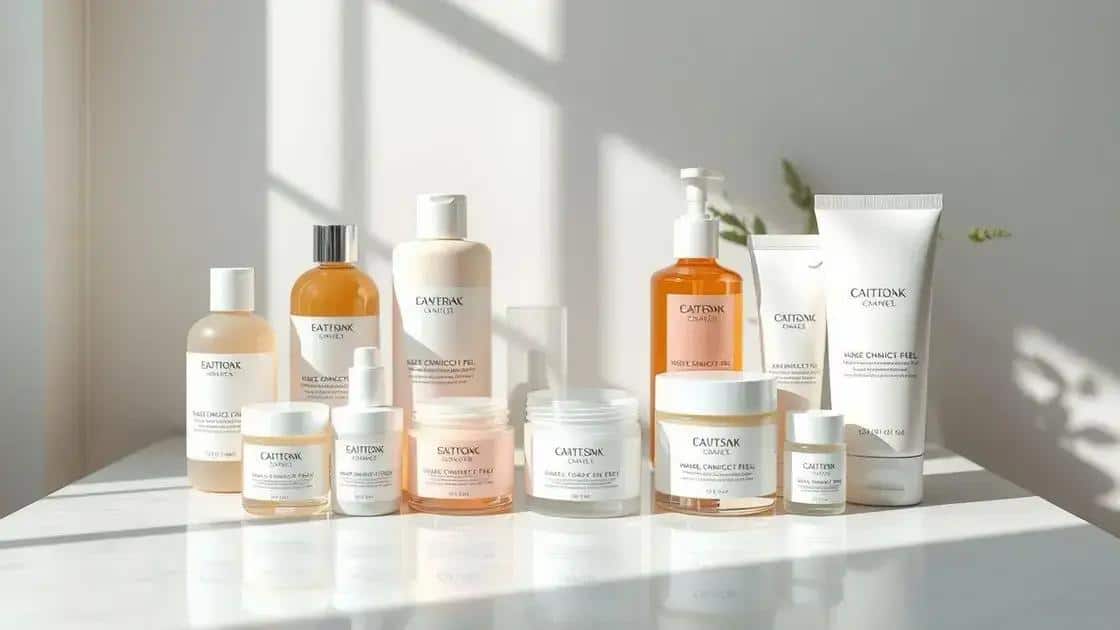If you’ve ever wondered about the best at-home chemical peels, you’ve come to the right place. These treatments can transform your skin while you enjoy a spa day at home. Ready to dive in?
Table of Contents
ToggleUnderstanding at-home chemical peels: A beginner’s guide?
Understanding at-home chemical peels can be the first step toward achieving healthier and more radiant skin. These peels are treatments with acids that help exfoliate the skin, removing dead cells and promoting cell renewal.
What are at-home chemical peels?
At-home chemical peels are products designed to be safe for use by individuals at home. They contain gentle acids, making them less potent than professional treatments. Common types include alpha hydroxy acids (AHAs) and beta hydroxy acids (BHAs).
How do they work?
These peels work by breaking down the bonds between dead skin cells. When applied, they effectively exfoliate the surface layers, revealing smoother and brighter skin underneath.
Who should use them?
At-home chemical peels are suitable for those looking to improve skin tone, texture, and minor blemishes. However, those with sensitive skin should start with lower concentrations to avoid irritation.
Preparation and safety
Before using a chemical peel, it is essential to perform a patch test. This step helps ensure that your skin does not have an adverse reaction. Always follow product instructions and consult a dermatologist if you’re unsure.
What to expect
After using an at-home peel, you may experience mild redness or peeling, which is normal. This is a sign that the peel is working. Ensure you follow up with a good moisturizer and sunscreen to protect your skin.
Frequency of use
It’s typically recommended to use at-home chemical peels every 2 to 4 weeks. This frequency allows the skin sufficient time to recover and regenerate.
Potential side effects
While at-home chemical peels are generally safe, side effects can include irritation, burning sensations, or prolonged redness. If any of these symptoms persist, stop use and consult a dermatologist.
Types of at-home chemical peels available and their effectiveness?
There are several types of at-home chemical peels available that cater to different skin types and concerns. Each type uses different acids that can provide various benefits.
Alpha Hydroxy Acids (AHAs)
AHAs are water-soluble acids derived from fruits. They help to exfoliate the skin, making them ideal for dry or sun-damaged skin. They promote cell turnover and improve the overall texture while also addressing fine lines.
Beta Hydroxy Acids (BHAs)
BHAs, such as salicylic acid, are oil-soluble and penetrate deeper into the pores. They are effective for oily and acne-prone skin as they help to unclog pores and reduce inflammation.
Jessner’s Solution
This combination peel includes AHAs and BHAs, along with resorcinol. It is great for reducing acne scars and hyperpigmentation. However, it is generally stronger and may not be suitable for sensitive skin.
Retinoid Peels
Retinoid peels can help improve skin texture by increasing cell turnover. They are effective for treating fine lines, wrinkles, and uneven skin tone. Users should be cautious, as these can cause irritation.
How to Choose
When selecting a peel, consider your skin type and the specific concerns you want to address. Always start with a lower concentration to avoid irritation and gradually increase as needed.
Effectiveness of At-Home Peels
At-home peels can effectively improve the skin’s appearance, but results can vary based on skin type and the product used. For best results, consistency is key. Regular use, along with a proper skincare routine, can enhance their effectiveness.
How do at-home chemical peels compare with professional treatments?
At-home chemical peels and professional treatments serve the same purpose: enhancing the skin’s appearance. However, there are key differences in potency and results.
Strength and Ingredients
Professional treatments typically use stronger formulations and higher concentrations of acids than at-home peels. This leads to quicker and more noticeable results but can also increase the risk of side effects.
Customization
Professional peels are often tailored to an individual’s skin type and concerns. Dermatologists assess the skin and select the appropriate type of peel, ensuring a more personalized approach.
Downtime and Recovery
At-home peels usually require little to no downtime. In contrast, professional peels may leave the skin red or peeling for a few days, requiring time at home to recover.
Cost
At-home chemical peels are generally much more affordable than professional treatments. They provide a cost-effective option for maintenance between visits to a dermatologist.
Safety Considerations
While at-home peels can be safe when used correctly, they may not be suitable for more complex skin issues. In such cases, professional treatments provide a safer option under expert supervision.
Frequency of Use
At-home peels can be used regularly, often every few weeks, while professional treatments are recommended every few months based on the skin’s needs. This staggering allows for effective and safe skin improvement.
Key factors to consider when choosing an at-home chemical peel?
When choosing an at-home chemical peel, several key factors can influence the effectiveness and safety of your treatment. Here are the important aspects to consider.
Skin Type
Knowing your skin type is crucial. If you have sensitive skin, opt for milder peels with lower concentrations of acids. For oily or acne-prone skin, stronger formulations may be beneficial.
Active Ingredients
Different peels use various active ingredients, such as AHAs, BHAs, or enzymes. Research the ingredients to ensure they match your skin concerns. For example, AHAs are good for dry skin, while BHAs are better for oily skin.
Concentration Levels
Pay attention to the concentration of acids in the peel. Lower concentrations are safer for beginners, while experienced users might benefit from stronger options. Start slow and progress as your skin adjusts.
Patch Testing
Always conduct a patch test before applying the peel to your entire face. This step helps identify any potential allergic reactions or sensitivities to the product.
Brand Reputation
Choose products from reputable brands with positive reviews. Look for those that provide clear information about ingredients and offer guidance on proper usage.
Post-Peel Care
Consider how easy it is to follow the post-peel care instructions. Aftercare is vital for protecting your skin and achieving the best results. Some peels may require specific follow-up treatments.
Step-by-step guide on how to safely apply an at-home chemical peel?
Applying an at-home chemical peel can be a rewarding experience if done safely. Here’s a step-by-step guide to help you achieve the best results without damaging your skin.
Step 1: Gather Your Supplies
Before you start, make sure to have everything you need. This includes your chosen chemical peel, a gentle cleanser, gauze or cotton pads, a timer, and a soothing moisturizer.
Step 2: Clean Your Skin
Wash your face with a gentle cleanser to remove makeup, dirt, and oils. Pat your skin dry with a clean towel before moving to the next step.
Step 3: Perform a Patch Test
It’s crucial to perform a patch test to check for any adverse reactions. Apply a small amount of the peel on a discreet area and wait 24 hours to see if there’s any irritation.
Step 4: Apply the Peel
Using a gauze pad or your fingers, apply a thin, even layer of the peel to your face, avoiding the eye area and any sensitive spots. Start timing according to the product instructions.
Step 5: Wait and Monitor
Keep the peel on for the recommended time. Monitor your skin for any excessive redness or discomfort during this period. If you experience severe burning or irritation, rinse it off immediately.
Step 6: Rinse Off
Once the designated time is up, rinse your face thoroughly with cool water to remove the peel. Make sure all product residues are washed away.
Step 7: Post-Peel Care
After rinsing, gently pat your face dry and apply a soothing moisturizer. It’s essential to keep your skin hydrated after the peel.
Step 8: Protect Your Skin
For the next few days, avoid direct sun exposure and use sunscreen daily. Your skin will be more sensitive after the peel, so protect it from environmental damage.
Potential risks and complications of at-home chemical peels?
While at-home chemical peels can improve your skin, they also come with potential risks and complications that you should be aware of.
Skin Irritation
One of the most common side effects is mild skin irritation. This can include redness, itching, or a burning sensation. Always perform a patch test to minimize this risk.
Chemical Burns
Improper use or leaving the peel on too long can lead to **chemical burns**. These can cause severe skin damage and may require medical treatment to heal.
Allergic Reactions
Some individuals may experience an allergic reaction to the ingredients in the peel. Symptoms can range from slight redness to severe swelling. Always check the ingredient list before using a new product.
Hyperpigmentation
In some cases, at-home peels can lead to hyperpigmentation, especially in individuals with darker skin tones. It’s essential to follow up with sunscreen to protect your skin.
Infection
Using non-sterile tools or not following proper aftercare can increase the risk of infection. Ensure that all tools are clean and that you follow aftercare instructions diligently.
Unpredictable Results
Results from at-home chemical peels can be unpredictable. Factors like skin type, product strength, and technique can all influence how well the peel works, potentially leading to disappointment.
How to enhance the results of your at-home chemical peel?
To get the most out of your at-home chemical peel, consider these tips to enhance its effectiveness.
1. Pre-Peel Preparation
Prepare your skin by gently exfoliating a few days before the peel. This will remove dead skin cells and help the chemical peel penetrate better. Use a mild cleanser to avoid irritation.
2. Follow Instructions Carefully
Always read and follow the instructions provided with your peel. Each product may have specific guidelines on application time, layers, and frequency.
3. Incorporate Hydration
Keep your skin hydrated before and after the peel. Use a hydrating serum or moisturizer to maintain moisture levels. Hydrated skin improves peel results and recovery.
4. Avoid Sun Exposure
Before and after the peel, minimize sun exposure. Sunlight can damage freshly peeled skin, leading to irritation and uneven results. Always use a broad-spectrum sunscreen.
5. Post-Peel Care Routine
After the peel, hydrate your skin and avoid using makeup for at least 24 hours. Opt for gentle, soothing skincare products to reduce the risk of irritation.
6. Regular Maintenance
To maintain results, consider scheduling peels every few weeks or months, depending on the product’s instructions. Consistent use can lead to better long-term skin improvements.
Tips on aftercare and skin maintenance post chemical peel?
After a chemical peel, proper aftercare is essential for achieving the best results and protecting your skin. Follow these tips for effective skin maintenance.
1. Keep Your Skin Hydrated
Maintain hydration by using a gentle, non-comedogenic moisturizer. Hydrated skin heals better and reduces the risk of irritation and peeling.
2. Avoid Sun Exposure
Protect your skin from sun exposure by wearing a broad-spectrum sunscreen with at least SPF 30. Newly peeled skin is more sensitive to UV rays and is at higher risk for sunburn.
3. Refrain from Exfoliating
Do not use exfoliating products for at least a week after the peel. This includes scrubs and products containing AHAs or BHAs. Allow your skin to naturally shed and heal.
4. Use Gentle Cleanser
Clean your face with a mild, fragrance-free cleanser. Avoid hot water and harsher cleansers that can irritate your sensitive skin.
5. Avoid Makeup
It’s best to avoid wearing makeup for at least 24 hours post-peel. If you must use makeup, opt for mineral-based products that are less likely to irritate your skin.
6. Monitor for Adverse Reactions
Pay attention to how your skin reacts after the peel. If you notice excessive redness, swelling, or any unusual symptoms, contact a dermatologist for guidance.
The future of at-home skincare: What’s next in chemical peels?
The future of at-home skincare looks promising, especially with advancements in chemical peels. Here are some trends and innovations to watch for.
1. Personalized Formulations
One trend is the shift towards personalized skincare solutions. Consumers may soon have access to custom chemical peels tailored to their unique skin types and concerns, made possible by advances in technology and skin analysis tools.
2. Innovative Ingredients
New ingredients are being developed for chemical peels that are more effective and less irritating. For example, next-generation acids and natural enzymes may provide enhanced exfoliation without the harsh side effects.
3. Sustainable Practices
As sustainability becomes more important, brands are focusing on eco-friendly packaging and formulations. Expect to see more organic and sustainably sourced ingredients in at-home peels.
4. Enhanced Safety Features
Future products may include built-in safety features such as indicators that notify users when to rinse the peel off, preventing over-exposure and reducing the risk of irritation.
5. Education and Resources
With the rise of at-home treatments, brands are likely to invest in educational resources. Users may have access to detailed guides, video tutorials, and virtual consultations to ensure safe and effective use of chemical peels.
How to Choose the Right At-Home Chemical Peel for Your Skin Type is important for achieving the best results without causing irritation or damage.
1. Determine Your Skin Type
Understanding whether you have oily, dry, combination, or sensitive skin will help you select the best peel. For example, oily skin types may benefit from BHAs, while dry skin types may prefer AHAs.
2. Assess Your Skin Concerns
Are you looking to treat acne, dark spots, or fine lines? Different peels target specific issues. Read the product descriptions carefully to ensure it aligns with your skincare goals.
3. Start with a Lower Concentration
If you’re new to chemical peels, opt for a lower concentration. This allows your skin to adjust and minimizes the risk of irritation or adverse reactions.
4. Check for Added Ingredients
Look for peels that include soothing ingredients like aloe vera or chamomile. These can help calm the skin and enhance your overall experience.
5. Read Reviews and Recommendations
Research products and pay attention to customer reviews. They can provide insight into the effectiveness and any potential side effects of the peel.
6. Consult with a Professional
When in doubt, consider consulting a dermatologist. They can recommend the best at-home chemical peel based on your individual skin needs.













